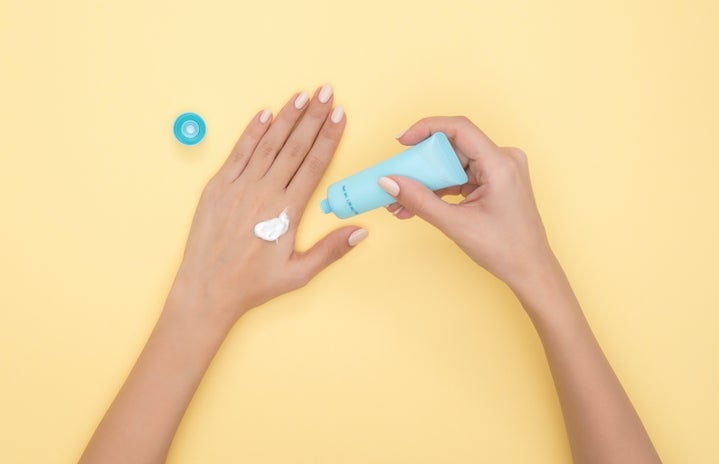Freckles, sunmarks, and tanlines. The hallmarks of summer are on the horizon. If you’re anything like me, you’ve probably already obsessed over the UV index and gone outside to tan. If you’re even more like me, you “forgot” to bring sunscreen and somehow “remembered” to bring tanning oil. Yes, those tan lines and glowing faces from the sun feels and looks nice, but there is a consequence – sunburns, sunspots, and sun damage.
Don’t fret, you can still lay out and tan with your gals as long as you integrate suncare into your daily routines. Wipe your memory clean of the days your mom would lather a thick white paste onto your nose, back, and arms before going swimming. Sunscreen has made progressions in the beauty world and is refined and easy to add into your routine.
But, what does sunscreen actually do and how does it work? Sunscreen serves one of two purposes to protect you from sunrays; absorption or reflection. This means that the chemical makeup of the sunscreen will include, “physical particles, such as zinc oxide and titanium dioxide … to reflect UV radiation from the skin … complex chemical ingredients in sunscreen react with radiation before it penetrates the skin, absorbing the rays and releasing the energy as heat,” wrote Isguvin for Yale Scientific. If chemistry isn’t your area of expertise, like me, we can leave the chemical properties and makeup of sunscreen to the scientists. But take one thing away, SUNSCREEN IS IMPORTANT.
So – you know sunscreen is important and how it protects you from UV rays, but now you may be wondering how to integrate it into your routine and where to start.
I’m sure you’ve seen the many numbers following the SPF on your bottles of sunscreen growing up – maybe ignoring what it means too. But these numbers are important in figuring out which sunscreen best suits your outdoor activity and amount of time in the sun. That special SPF number is the amount of time it takes for those rays to “redden the skin with sunscreen compared to without sunscreen.” For example, SPF30 will protect you from the rays 30 times longer than if you don’t wear sunscreen at all.
The normal application process of body sunscreen hasn’t changed since you were a kid – meaning apply sunscreen 15 or so minutes before you intend to be outside and let it fully dry before you get wet. Pay attention to the specific instructions on re application as some sunscreen will wash away if you are getting in and out of the water. Another note to make when choosing your body sunscreen is the ingredients. Hawaii actually bans the use of sunscreen that contains oxybenzone and octinoxate to protect native coral reefs. Check with where you are planning on swimming to make sure you aren’t violating local sunscreen rules.
Facial sunscreen is a whole other monster where every skincare company comes out with their own line of suncare. Like any other aspect of skin care, there are different types of sunscreen that cater to oily, normal, or dry skin. Sunscreen is typically applied as the last or second to last step in your skincare routine. If your moisturizer already includes SPF you’re in luck. If not, apply after your moisturizer as your last layer before applying makeup.
There are a plethora of body and face sunscreens on the market and I’ll leave comprehensive reviews to the experts like Hyram. But if you want to get basic reviews on the ones I’ve used, keep reading.
SunBum Original Sunscreen Spray SPF50: SunBum has one of the cutest aesthetics for sun care brands and other products that are just as great. This sunscreen is easy to apply as it is a constant mister and erases the minutes spent rubbing it into your arms. It is also SPF50 which is a moderate level of protection for most outdoor activities. Pick it up at your local drugstore or Ulta for around $15 a bottle. (PS – throw in their SPF chapstick, it smells great)
Sun Bum Mineral SPF 30 Sunscreen Face Lotion Tinted: I just bought this tinted face sunscreen and so far I’m loving it. The last couple of sunny days I’ve been using it as a foundation to keep my face feeling light. This sunscreen has a mousse-y velvety feeling and has no white cast. This mineral sunscreen runs at around 18 dollars per bottle and trust me, a little goes a long way;this bottle should last you awhile.
Supergoop! Matte Screen SPF 40: If you’re looking for a lighter coverage tinted sunscreen, this matte screen is for you. Like the Sun Bum one, this sunscreen leaves your skin feeling light and has a light amount of coverage. However, this one runs at a higher price, $38. It is more expensive than SunBum, but look into the brand, Supergoop has a bunch of other types you may be interested in.
Glossier Invisible Shield SPF 35 Clear Daily Sunscreen: If you aren’t a fan of tinted sunscreens, you’re in luck. This glossier sunscreen is perfectly clear and has no white cast. I’ve integrated this sunscreen into my daily routine regardless of the season and always feel refreshed after applying. Running at only $25, this is a great sunscreen to purchase. (PS – my whole makeup routine is basically Glossier so if this brand isn’t your favorite don’t worry there’s so many other sunscreens out there)
If you take one thing from this article it is that sunscreen is soooo important. Even in the winter or less sunny seasons, sunscreen protects your skin from rays when the clouds convince you that you’re not at risk. Implement it into your skin routine and remember to grab the bottle before you head out to the beach. Don’t let sunbuns and sunspots ruin your summer.


